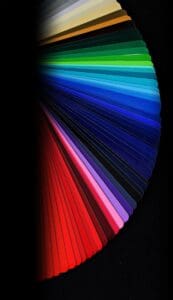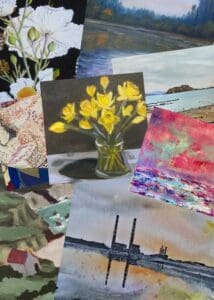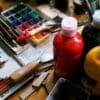Framing a watercolor painting is quite different from framing an oil or acrylic piece. For watercolors, there is the matting to consider, the type of glass to use, and the actual frame. An important thing to remember is that the matting and backing should be made of acid free materials. A reputable framer will recommend this, but it is still a good idea to check on this point during the selection process. If acid free products are not used, the bevel-cut edge of the matt (the narrow angled cut which lays next to the artwork) will discolor over time, and the painting itself may become affected.
Your framer will show you a variety of mats from which to choose. They will vary in texture and color, and the choices may seem overwhelming. You will be asked if you’d like to use single, double, or even triple mats for your painting. I generally select a double mat, and rarely a triple. (I reserve this option for very large pieces only.) The single mat often does not do the artwork justice, and I don’t go this route. The right mat choice will enhance your painting, while protecting it by placing an air pocket between your watercolor and the glass.
A “double mat” is one mat placed on top of a second one, with only a quarter inch or less of the bottom mat showing, directly around the artwork. This extra dimension adds depth and interest to the overall appearance of the framed painting. The two mats do not necessarily need to be the same color, but should pick up those which are in the painting, and not just colors which will match your sofa! When choosing a white mat, select one close to the white of your watercolor paper which show in your piece. This will blend nicely and not stand out as too bright, or too dull in comparison to the paper. It is surprising how many “whites” there actually are! Have your framer place the samples you’re considering at each corner of the painting, one at a time, to assure they look well with all parts of your watercolor. What works well at the upper left corner of your painting, may not look right when placed near the bottom righthand section of your work.
Glass is also an important consideration when framing a watercolor painting. Clear, non-glare, conservation, and plexiglass are all options. The choice between clear and non-glare glass I consider to be a personal preference. The conservation glass, although more expensive, does as the name implies; it best conserves your artwork. Discuss these types of glass with your framer. Often if the place where the painting will hang is known, one’s decision about glass type will be easier to make. It is not recommended to hang a watercolor painting in areas of high humidity (such as a bathroom, or near a stove top.) Also exposure to direct, prolonged sunlight is not recommended.
If your painting will be for sale, the best choice will be the conservation glass. This will also be an excellent selling point to include in the description of the framed piece. Mention that acid-free materials (including the backing) have been used also.
Plexiglass is often required when a watercolor painting will be entered into an art show. It is lighter in weight and will not break, but keep in mind that it scratches very easily!
Last but not least, is the selection of moulding, (frame) for your watercolor. There are many, many widths, styles, surfaces, and colors from which to choose. A good rule of thumb is not to select a color which is any darker than the darkest dark in your painting. The frame needs to compliment your artwork, not compete with it. Soft grays and subtle golds usually work well with watercolors. A good, reputable framer will help you choose the width and color frame which best suits your painting, and will always ensure acid free materials are used!
Disclaimer: The views and opinions expressed in this article are those of the authors and do not necessarily reflect the official policy or position of Irish Artmart.




